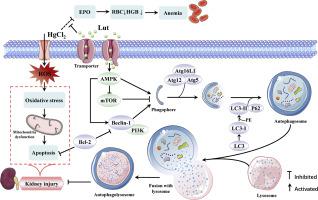Journal of Inorganic Biochemistry ( IF 3.8 ) Pub Date : 2021-08-19 , DOI: 10.1016/j.jinorgbio.2021.111583 Xinyue Xu 1 , Zhongxian Yu 2 , Biqi Han 1 , Siyu Li 1 , Yingshuo Sun 1 , Yu Du 1 , Ziwei Wang 1 , Di Gao 1 , Zhigang Zhang 3

|
Inorganic mercury is a ubiquitous toxic pollutant in the environment. Exposure to inorganic mercury can cause various poisonous effects, including kidney injury. However, no safe and effective treatment for kidney injury caused by inorganic mercury has been found and used. Luteolin (Lut) possesses various beneficial bioactivities. Here, our research aims to investigate the protective effect of Lut on renal injury induced by mercury chloride (HgCl2) and identify the underlying autophagy regulation mechanism. Twenty-eight 6–8 weeks old Wistar rats were randomly assigned to four groups: control, HgCl2, HgCl2 + Lut, and Lut. We performed the determination of oxidative stress and renal function indicators, histopathological analysis, the terminal deoxynucleotidyl transferase-mediated deoxyuracil nucleoside triphosphate nick-end labeling assay to detect apoptosis, western blot detection of autophagy-related protein levels, and atomic absorption method to detect mercury content. Our results showed that Lut ameliorated oxidative stress, apoptosis and restored the autophagy and renal function caused by HgCl2 in rats. Concretely, the level of nuclear factor E2-related factor, renal adenosine monophosphate-activated protein kinase (AMPK) expression, and autophagy regulation-related proteins levels were down-regulated, and the mammalian target of rapamycin (mTOR) expression was up-regulated by HgCl2 treatment. However, Lut treatment reversed the above changes. Notably, Lut reduced the accumulation of HgCl2 in the kidneys and promoted the excretion of HgCl2 through urine. Collectively, our results demonstrate that Lut can attenuate inorganic mercury-induced renal injury via activating the AMPK/mTOR autophagy pathway. Therefore, Lut may be a potential biological medicine to protect against renal damage induced by HgCl2.
中文翻译:

木犀草素通过激活 AMPK/mTOR 自噬通路减轻无机汞引起的肾损伤
无机汞是环境中普遍存在的有毒污染物。接触无机汞会导致各种有毒影响,包括肾损伤。然而,尚未发现和使用无机汞引起的肾损伤的安全有效的治疗方法。木犀草素 (Lut) 具有多种有益的生物活性。在这里,我们的研究旨在研究 Lut 对氯化汞 (HgCl 2 ) 引起的肾损伤的保护作用,并确定潜在的自噬调节机制。28 只 6-8 周大的 Wistar 大鼠被随机分配到四组:对照组、HgCl 2、HgCl 2 + 卢特和卢特。我们进行了氧化应激和肾功能指标的测定,组织病理学分析,末端脱氧核苷酸转移酶介导的脱氧尿嘧啶核苷三磷酸缺口末端标记法检测细胞凋亡,蛋白质印迹检测自噬相关蛋白水平,原子吸收法检测汞内容。我们的研究结果表明,Lut 改善了大鼠体内由 HgCl 2引起的氧化应激、细胞凋亡并恢复了自噬和肾功能。具体而言,核因子 E2 相关因子、肾腺苷一磷酸活化蛋白激酶 (AMPK) 表达和自噬调节相关蛋白水平下调,哺乳动物雷帕霉素靶蛋白 (mTOR) 表达上调通过 HgCl 2治疗。然而,Lut 治疗扭转了上述变化。值得注意的是,Lut 减少了 HgCl 2在肾脏中的积累,并促进了 HgCl 2通过尿液的排泄。总的来说,我们的研究结果表明,Lut 可以通过激活 AMPK/mTOR 自噬途径来减轻无机汞诱导的肾损伤。因此,Lut可能是一种潜在的生物药物,可以防止HgCl 2引起的肾损伤。











































 京公网安备 11010802027423号
京公网安备 11010802027423号